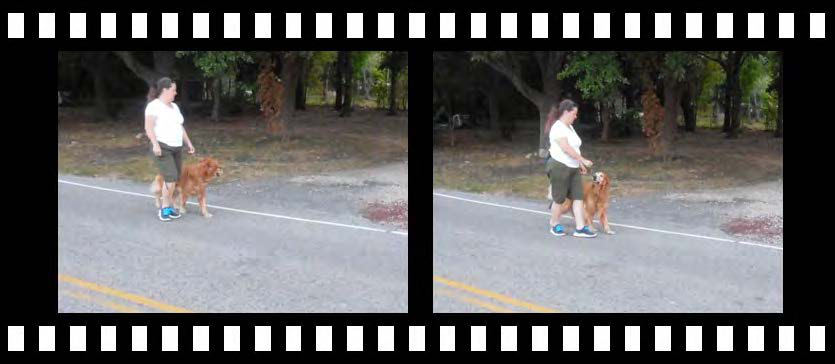
Read part II here: Teaching Reactive Dogs A New Habit, Part II: “Look At That!”
Do any of these statements describe your dog?
Your dog over-reacts to exciting stimuli, especially another dog walking by.
He barks and lunges at passing skateboards, bikes, or other dogs, like he wants to attack them!
Molly barks at people when they come to visit or when she’s out on a walk.
Rover enjoys being outside with you while you work in the yard, but forget it if a bicycle goes by!
Rufus walks great on a leash, unless someone else with a dog comes along.
Yes! My dog goes crazy and it’s scary when she barks and lunges!
None of this means that your dog is a bad dog. She just needs to learn a different behavior to perform when one of these events happens. We can change her behavior by changing our own behavior when we confront the things that make her crazy! The “Open Bar” technique will help you (1) desensitize your dog to whatever upsets her, and (2) counter-condition her response of barking and lunging. You can actually teach your dog to be calm and check with you when the things happen that used to turn her into a raving maniac. Start with Pavlovian Conditioning, a.k.a. Classical Conditioning to turn this freight train around.
How “Open Bar” works:
The idea behind “Open Bar” is that when your dog sees a dog, bicycle or person nearby, whatever tends to cause barking and lunging, he gets lots of treats — and he gets them before he reacts, but while the stimulus is occurring. In other words, when the cue to over-react is present, the treat bar is open. Once the cue to react is gone, the bar closes. Everything else should remain the same so your dog gets the message that the presence of his “nemesis” now causes treats to happen. His “nemesis” will become a signal to check with you, salivate, and anticipate treats and fun!
Your dog will learn to notice the cue to over-react, but it will come to mean it’s time to look to you for good things and guidance, remaining calm. This behavior will replace the previous behavior of barking and lunging.
The stimulus that causes the barking and lunging will become a stimulus for a completely new behavior – happily checking in.
How to start training
To teach this, it is essential for you to be aware of the cue before your dog is, so that you are prepared to train. You must also make sure that the cue – the person, dog, bicycle, whatever it is – is far enough away and as non-threatening as possible. Don’t expect your dog to suddenly calmly tolerate another dog 10 feet away or a human walking toward him with her hand out; your dog has already “told” you what he feels he needs to do in these situations. You must prevent the behavior you don’t want while you’re setting up controlled situations to get that calm behavior you’re looking for. Keep your dog on a leash, but a loose leash. Make sure you have the leash skills necessary as a team to stay together. Your dog must be comfortable sitting, lying down, or standing next to you and that will require some space to allow your dog to relax.
Treats are your training tools
When you go for a walk, be prepared with a bag of fabulicious food treats — treats your dog will do anything to get — broken into bite-size pieces. If your problem is your dog’s response to visitors coming in the house, don’t be caught without a treat bag on, filled with the best small treats, when the visitor arrives.
Using “Open Bar” when you’re out on a walk
If you can monitor the situation outside well enough, seeing the “problems” before your dog notices or at least when they’re still at a distance at which you can control your dog, take a normal stroll with Rufus. When you see Mr. Smith and Fido turn the corner, starting to approach you on the other side of the street, grab a handful of roasted chicken bits from your treat bag, and begin feeding Rufus one treat at a time as fast as you can. Pay full attention to Rufus until the dog passes by, praising and feeding him while you continue to walk. Focus completely on Rufus. He’ll be focused on you, his mind happily on scarfing down treats. Ignore Mr. Smith! You can’t take time to chat right now because you’re training your dog. You can explain later. Once Mr. Smith and Fido have passed, and you’ve put enough distance between yourself and the other dog, stop feeding Rufus and go back to walking along normally.
Practice with bikes and skateboards and cars as they pass, even if your dog doesn’t over-react to those. It will give both of you good practice for the times when the real stimulus comes along.
You’ll need a back-up plan
If your dog begins becoming aroused beyond the point at which he’ll take the treats, you’ll need to enact a back-up plan that you’ve already thought ahead about: duck behind a parked car or a big tree or shrub. Blocking your dog’s visual access can really help you prevent the behavior you don’t want – the barking and lunging. Continue to feed him treats; he can still hear and smell the other dog, so a good association still has a chance to happen.
Using “Open Bar” at home
If the problem is visitors to your home, don’t take your dog to the door to let them in! Make a plan that has you and your dog on the other side of the room, farthest from the door. It may help to sit in a chair or even on the floor with your dog to help him feel comfortable. Have him on a leash – again, always a loose leash – just have it on as a safety measure. The second the door opens and the visitor starts to walk in, perhaps when the visitor comes to the door or when the doorbell rings, open the bar. Give a steady stream of treats. Remember, this is simply Pavlovian conditioning – don’t ask your dog for any specific behavior, just associate the presence of the visitor with tasty treats.
Interaction with a visitor isn’t the goal at first
Do not expect your dog and the visitor to interact; in fact, don’t even consider it the first few times. Give your dog a chance to understand that all he has to do is relax and the visitor will be in the room, but won’t approach him. That’s enough for now. In fact, it’s enough forever if your dog doesn’t want to interact; however, it’s likely that when your “Open Bar” behavior modification project has gone on long enough, your dog will offer friendly gestures to visitors who behave appropriately (use non-threatening body language and allow the dog to approach them when he’s ready). Our online Dog Reading Course can help you teach your visitors how to appropriately interact with your dog.
Limit exposure time
You may find it helpful to limit the amount of time your dog is in the room with a visitor. This new procedure is quite a big change for him and that can be stressful. After a few minutes, take him to his confinement area where he can feel safe and relax for a bit. Bring him back out after the visitor leaves.
What is “enough distance” for a reactive dog?
You and Rufus know what enough distance needs to be: “enough distance” means how far Rufus has to be from the distraction before he becomes calm again after passing. It’s also the distance at which he’s still calm when another dog first appears – before he turns into a lunatic. It’s also the distance inside your home from a visitor who is ignoring or at least not threatening your dog. Notice that distance, and start giving treats right then. You’ll see the distance decrease as you do the training.
Remember that there are other factors besides distance. Whether or not another dog is moving directly toward your dog matters. How excited another dog is – whether it is running or walking slowly – matters. A human visitor should be instructed to be calm and relaxed and not try to entice your dog to come to them. If you’re working with a non-breathing stimulus like a bike or car, start with a parked vehicle; work up to movement.
Don’t accidentally cause your dog to get too close to the stimulus.
You must be vigilant to prevent the behaviors you don’t want. You have to notice the dog before Rufus does. You can’t wait until he is already amped-up before opening the bar. A dog who is in the midst of reacting isn’t open to learning a new behavior. If he starts barking and lunging, abort the mission! Your best bet is to get out of there: turn around and head the other direction; cross the street; go behind a car to provide a visual barrier. If your dog is smaller, you can pick him up and carry him away, reminding yourself to pay closer attention next time.
Working with visitors in your home, you must control the situation. Have people text you before they arrive; don’t let them ring the doorbell if that arouses Rufus. It’s only within controlled situations that you can carefully teach your dog what you want him to learn.
“Open Bar” is part of a teaching process.
Remember that every time your dog practices barking and lunging, he gets better at it, and the habit becomes more ingrained. You’d rather he practice the behavior of looking to you for super-awesome treats when he sees another dog, a human, or whatever his current “nemesis” happens to be – and with practice, he will. (Thanks to Jean Donaldson for the catchy name of this exercise.)

